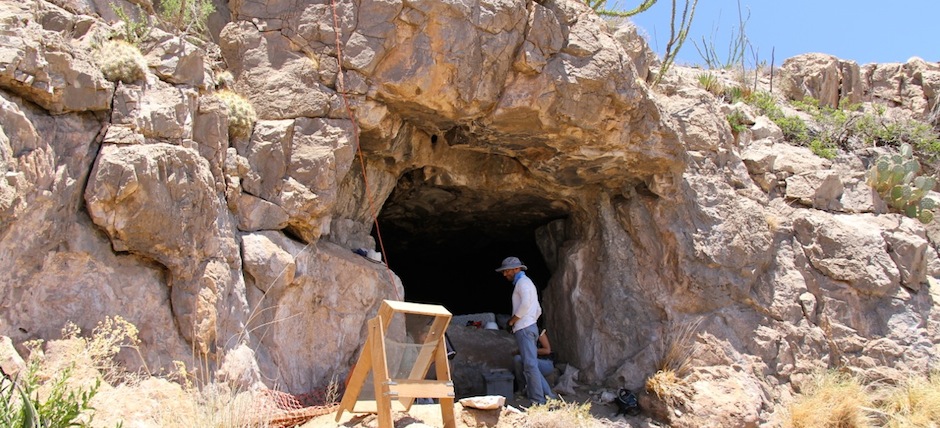It is well-accepted that the earliest human habitation in North America dates to about 12,000-years ago. What if that date is wrong by at least 23,000-years?!
Recently, the Debra L. Friedkin site, a Pre-Clovis, Paleoindian and Archaic period site located in the alluvial floodplain of Buttermilk Creek in central Texas, has yielded Optically Stimulated Luminescence Dating (OSL) dates that suggest the site was occupied 15,500-years ago. In all, 63 OSL dates have been obtained from the site to support this statement. Currently, these stand as the oldest credible archaeological site dates in Texas. Radiocarbon dating has not yet been possible due to poor preservation of organic material.
In contrast, the Circle Ranch Indian Cave is completely covered, completely dry, and contains over 10-feet of deposits above the cave’s floor. An almost-perfect time capsule, which has preserved organic material for tens of thousands of years.
Animal remains preserved in Cave.
The document displayed below provides the results of the latest round of Accelator Mass Spectrometry (AMS) radiocarbon dating. We now have four (4) different carbon dates of charcoal in the Circle Ranch Indian Cave which date the charcoal to 35,000-years ago.
At this point, it’s difficult to confidently assert that humans were in the cave approximately 35,000-years before now. While the evidence seems to be heading in that direction, we need to make sure our facts all line up before drawing hard conclusions.
Some things to consider are: Because charcoal is present in at least two portions of the cave, it’s possible that charcoal is scattered throughout the cave. In other words, Stratum F is horizontally continuous and likely covers a good portion of the cave at these depths. This distribution may be in “feature” contexts, or as “scatters” of burned wood and ashes.
The charcoal’s source and nature is tricky to identify. Theoretically, a natural burn outside the cave could have produced the charcoal, which was then transported into the cave by wind or animals 35,000-years ago. Or we could have a situation where people burned packrat middens 20,000 + years after it was initially deposited.
These scenarios would seem unlikely, but possible, and, 23,000-years is a long time. Asking questions like these is how the archaeological community will evaluate and verify these dates, trying to make sense of them. It is just good science.
In sum, we have artifacts associated with bones that date (relatively) to around 35,000-years ago. According to Dr. Harris, “The vulture could very easily be that old (and then some). The dates fit nicely with some of the fauna we’ve recovered (such as the Aztlan rabbit and the vampire bat) that almost certainly are mid-Wisconsin in age.”
AND, the charcoal that was recently dated, from Excavation Unit-2 (EU-2), is stratigraphically associated with the vulture bones (Coragyps occidentalis) and a few flakes. Javi Vasquez’s master’s thesis provides much more information on what was found at EU-2:
https://pitchstonewaters.com/circle-ranch-indian-cave/#more-30
We have four radiocarbon dates that put the lower strats at the 30K+ mark. This May, 2013, we will continue and intensify the dig, which is being supported by a grant from National Geographic .
Per Javi Vasquez:
To date, the evidence suggests that humans occupied Sierra Diablo Cave approximately 35,000-years ago. In support of this statement, we have four separate charcoal samples that were AMS dated from two separate sampling locales, with approximately 12 meters of horizontal distance separating them. Furthermore, the faunal assemblage is Pleistocene in age at those depths (Strata E and F), and several species certainly would have been around 35,000-years ago. Some of these specimens exhibit evidence of butchering/burning.
A large biface/knife was recovered as well as what appears to be a very well-preserved bone point.
The implications of these associations will obviously be contended, as expected. Consequently, a reexamination of these data, the stratigraphy, the artifacts, and the faunal remains, in addition to more radiocarbon dating, is required. Optically stimulated luminescence dating (OSL dating) is also planned. To date, we have exposed about eight total square meters, of Strata E and F, out of possibly 310 m²; more than 95 percent of the cave remains unexplored at those levels. We have scheduled 20-days of excavation this May, funded by National Geographic and the Argonaut Archaeological Research Fund (a privately endowed research program focused on understanding the earliest peopling of the Greater Southwest headed by Dr. Vance T. Holliday), that will target very specific areas; these efforts may yield more data to either support or disprove the idea that humans were present in Texas, at Circle Ranch, more than 20,000-years before Clovis. My aim is to present accurate data; everything else will work itself out.
Thank you for all the support!
Regards,
J. Javi Vasquez, M.A.
Archaeologist, TRC Environmental”
El Paso, TX
If these dates prove up, Javi’s new address will be:
Archaeologists’ Protection Program
c/o Circle Ranch
Circle Ranch “Científicas” are acknowledged to be the prettiest in the Southwest.

